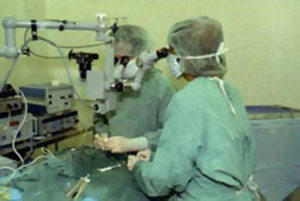The biology component of the Project is geared to address two main concerns: 1) to determine optimal parameters of electrical stimulation of the retina and 2) to identify ideal biocompatible materials that will ultimately be used for the retinal prosthesis.

Two surgeons from the implant team perform surgery at the animal surgical facilities of the Massachusetts Institute of Technology.
To help us answer these questions, we carry out experiments using animal models. This includes electrophysiological recordings from neurons of the visual system to determine the electrical stimulation parameters necessary to generate visual percepts that will be ultimately interpreted as functional vision. Specifically, we are attempting to determine the parameters that enable the selective activation of targeted cells surviving in the retina and the minimization of the electrical current needed to stimulate the retina safely.
In addition, we investigate the issue of biocompatibility of implant materials. This involves the surgical implantation of various materials and the microscopic cellular evaluation of how the animal tissue reacts to the retinal implant. These studies are very important in order to help evaluate materials that can be used safely within the eye for prolonged periods of time as well as identify those that could be potentially damaging.
